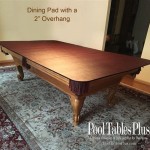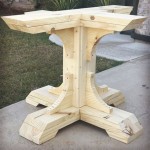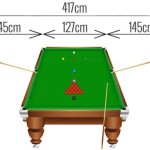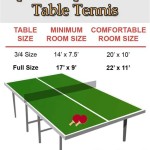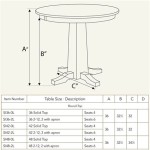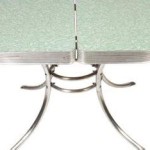What Is The Standard Size Of A Bar Pool Table?
When considering the purchase or placement of a pool table, understanding the standard dimensions is crucial. Pool tables come in various sizes, each suited for different spaces and playing environments. While larger tables are typically found in professional settings or homes with ample room, bar pool tables, also known as coin-operated pool tables, maintain a more compact profile. This article delves into the standard size of a bar pool table, exploring its dimensions, playing surface area, and the rationale behind its specific measurements. It also discusses the necessary space around the table for comfortable gameplay. Understanding these aspects will provide a comprehensive overview for anyone looking to buy, install, or simply learn more about bar pool tables.
The term "standard size" can be misleading as bar pool tables can also exist in variations. However, a generally accepted and commonly encountered dimension exists, primarily driven by ease of placement within commercial establishments and the desire to optimize game accessibility for a wider range of players. It is important to note that variations can exist depending on the manufacturer, age, and origin of the table, but the following dimensions represent the most prevalent standard.
Typically, bar pool tables are smaller than those found in private residences or professional billiard halls. This is because bars and pubs often have limited space. The size reduction allows more tables to be placed in a given area, maximizing revenue generation for the establishment. A standard home pool table is usually 8 or 9 feet in length, while bar pool tables commonly fall into a smaller size category, measured by the playing surface, not the table's total exterior dimensions.
The Playing Surface Dimensions
The "playing surface" refers to the area within the cushions where the balls are actively played. The size of the playing surface is what is commonly used to denote the "size" of a pool table. For bar pool tables, the standard playing surface is approximately 3.5 feet by 7 feet. This translates to 42 inches by 84 inches, or 106.7 cm by 213.4 cm. This measurement is critical because it directly impacts gameplay dynamics, including shot execution, ball movement, and overall game difficulty.
The playing surface is enclosed by the cushions or rails, which are typically made of rubber or synthetic materials and covered in cloth matching the playing surface. These cushions are designed to provide consistent ball rebound, contributing to the predictability and strategic depth of the game. The thickness and composition of the cushions can also vary, subtly affecting gameplay. However, the 3.5 x 7-foot playing surface remains the consistent determinant of a "standard" bar pool table.
It's important to distinguish between the "playing surface" and the overall table dimensions. The overall table length and width will be larger than the playing surface due to the inclusion of the rails/cushions and the cabinet or frame that supports the table and the coin mechanism. Always focus on the playing surface dimensions when comparing table sizes.
The dimensions of the playing surface directly impact the difficulty of the game. A smaller table necessitates greater precision and control, as the distances between balls are reduced, and angles become more acute. This can lead to a more fast-paced and challenging game, appealing to experienced players while still being accessible to novices. Furthermore, a smaller table often requires players to develop strong positional play, utilizing the cushions and strategic ball placement to control the game. This difference in playing dynamics compared to larger tables explains why skilled players adapt their strategies when playing on bar pool tables.
Space Requirements Around the Table
Knowing the playing surface dimensions is only half the battle. Adequate space around the table is essential for comfortable gameplay. Players need room to maneuver, address the cue ball, and execute shots without obstruction. The required space depends on the length of the cue being used.
Ideally, there should be at least 5 feet of free space around all sides of the table. This means that for a standard 3.5 x 7-foot bar pool table, a room size of at least 13.5 feet by 17 feet is recommended. This allows players to comfortably shoot from any angle without the cue hitting a wall, furniture, or other players. If space is limited, shorter cues can be used, but this can compromise shot accuracy and power, especially for longer shots. Therefore, prioritizing sufficient space is vital for an enjoyable and fair playing experience.
Obstructions to be accounted for include not only walls but also furniture, support columns, and other fixtures within the room. The placement of these elements relative to the pool table can significantly impact the usability of the space. Careful consideration should be given to optimizing table placement to minimize obstructions and maximize player comfort. Bars and pubs often utilize strategic placement to balance table accessibility with efficient use of available floor space.
Furthermore, consider the lighting above the table. Adequate and well-positioned lighting is essential for clear visibility and accurate shot execution. The lighting should be bright enough to illuminate the entire playing surface evenly, without creating excessive glare or shadows. The position of the lighting should also be considered in relation to player movement to avoid potential obstructions or hazards. Proper lighting is a critical component for a positive gameplay experience and overall safety in the playing area.
Variations and Considerations
While the 3.5 x 7-foot playing surface is considered the standard for bar pool tables, variations do exist. These variations may be due to manufacturing differences, regional preferences, or the age of the table. Some older tables may have slightly different dimensions. It is also possible to find bar pool tables that are slightly larger or smaller than the standard, though these are less common.
Another critical consideration is the quality of the table itself. The construction materials, the quality of the slate bed (which supports the playing surface), and the quality of the cushions and cloth all significantly impact gameplay. A poorly constructed table can have an uneven playing surface, inconsistent cushion rebound, and cloth that wears quickly, leading to a frustrating and unreliable playing experience. Therefore, it is essential to consider the overall quality and condition of the table, not just its dimensions.
Additionally, the coin-operated mechanism itself can add to the overall dimensions and weight of the table. The mechanism must be reliable and durable to withstand frequent use in a commercial setting. The ease of maintenance and coin collection should also be considered. A well-designed and maintained coin mechanism is essential for the table's effective operation and revenue generation.
Ultimately, the "standard" size is a guide, and each location and player may have slightly different needs and preferences. However, the 3.5 x 7-foot playing surface for a bar pool table represents a widely accepted and practical compromise between gameplay experience and space efficiency, making it a common sight in bars and pubs worldwide.

The Official Size Of A Pool Table Canadian Home Leisure

What Is The Standard Size Of A Pool Table Measurement Guide Room

Pool Table Room Size Guide Chart Birkbeck Billiards

Pool Table Room Size Calculator

How Tall Is A Standard Pool Table Height Guide Bar 101

What Is The Standard Pool Table Size Bar 101

Room Size Pooltables Com

Correct Pool Table Dimensions To Leave Enough Room For Playing Billiard

Pool Table Room Size Guide Chart Birkbeck Billiards

Pool Table Room Size Guide Home

